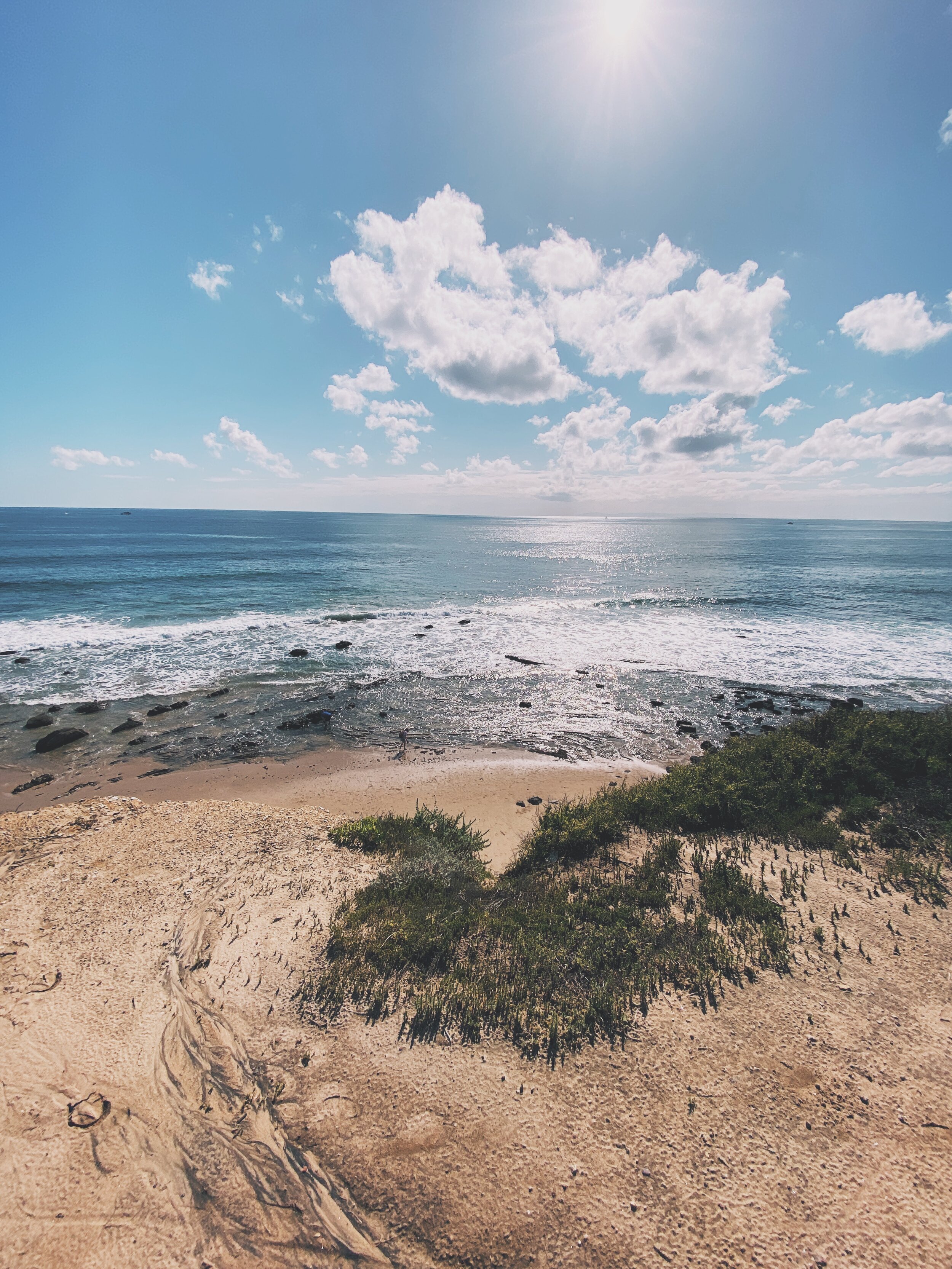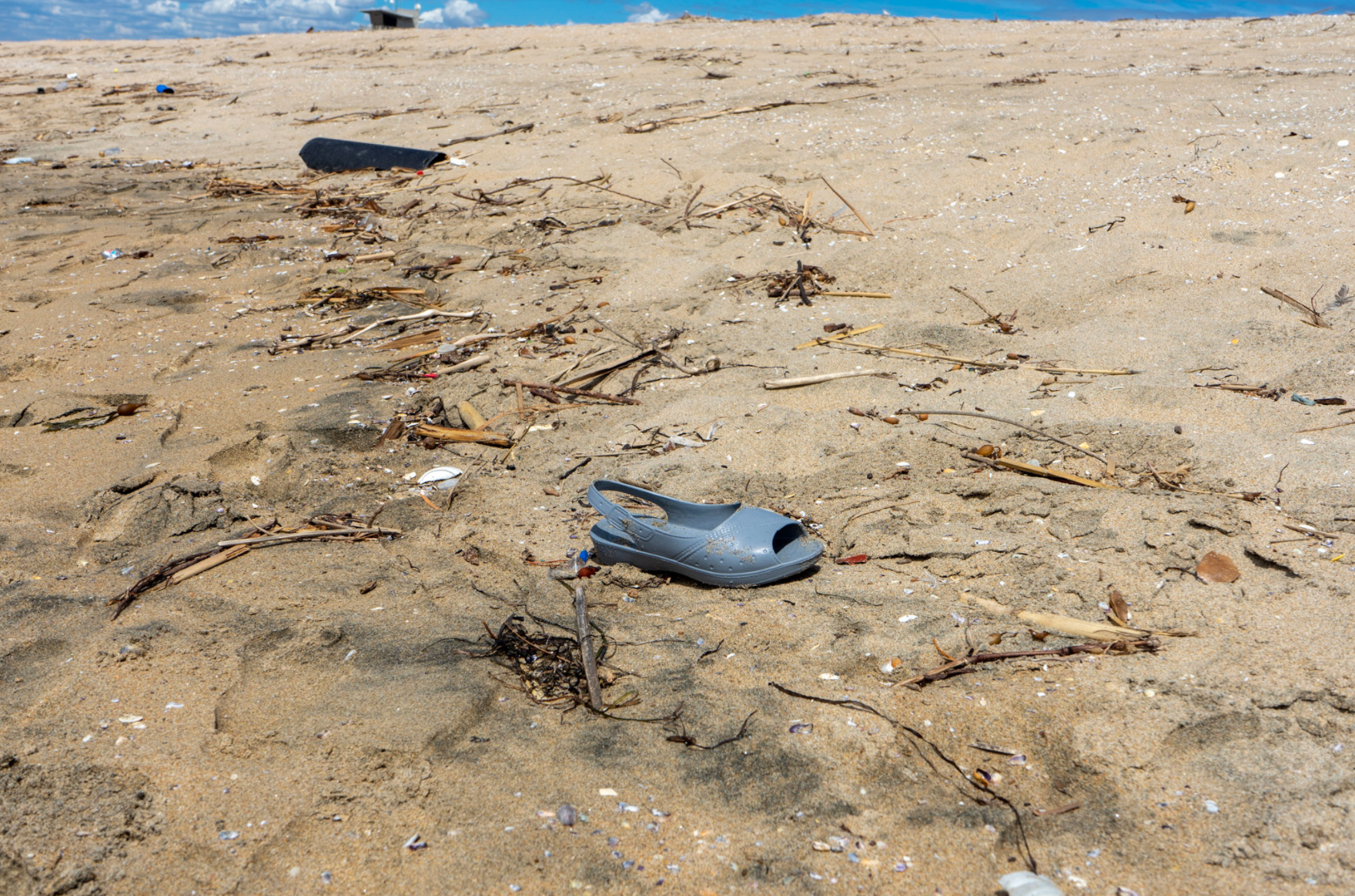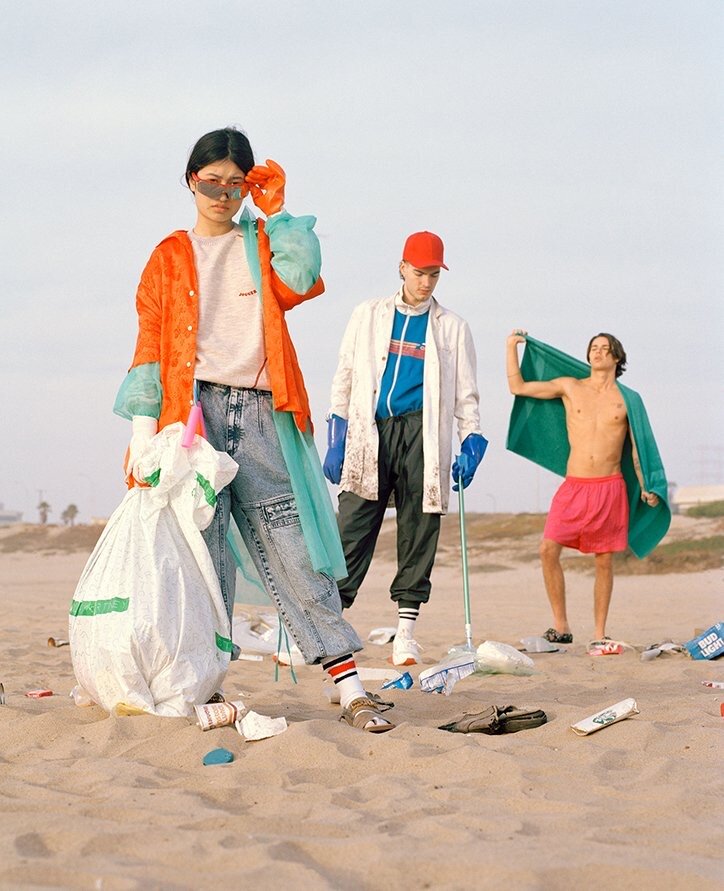
Fashion’s Impact on our Oceans.
By Emma Golley
As a Fashion Designer, I know that many of us struggle justifying the harmful impact the fashion industry has on the environment.
A couple months back, a storm washed up an overwhelming amount of trash on a local beach. My boyfriend and a colleague of mine joined me in an attempt to clean up as much of it as we could. Three hours and 3 miles of beach later, our buckets and trash bags were full of countless bottle caps, children’s toys and food wrappers. But what surprised us the most were the numerous shoes and beauty products littering the sand.
When most of us think about Fashion and the impact it has on our planet, we tend to focus our attention on the effects of excess consumption and a high carbon footprint. But the direct effect it has on our oceans is equally as important.
With it being the UN World Oceans day today (June 8th), what better time to highlight these facts about how clothing pollutes the oceans, and some small changes we can make to have a positive impact.
Microfibers.
Every time your clothes are washed they shed tiny plastic fibers called microfibers. The average wash cycle releases 700,000 microfibers into the water system. Synthetic fabrics such as polyester, nylon and acrylic are among the biggest culprits. These microfibers are so small, water treatment plants and filters can’t catch them all, so they end up making their way into our oceans and rivers.
Each year, clothes washing around the world releases half a million tonnes of these small plastic fibers into the ocean. This is equivalent to more than 50 billion plastic bottles and almost 3 billion polyester shirts. (1)
Its estimated that 85% of human-made debris littering shorelines around the world is synthetic microfibers.
For more information, take a look at these two useful videos:
Photo by Emma Golley
Wastewater.
The Fashion Industry is responsible for 20 percent of global wastewater - the equivalent to more than half a trillion gallons of freshwater.
Many clothes using dyeing and finishing processes rely on toxic chemicals which can affect the health of workers, and leach out into rivers and ground water systems - degrading the land, compromising drinking water and killing fish. (2)
In India and Bangladesh, dye wastewater is discharged, often untreated, into nearby rivers that eventually spread into the sea. Reports have suggested this may be linked to a dramatic rise of diseases in these regions.
In China, the world’s largest clothes exporter, the State’s Environmental Protection Administration declared that nearly one third of the countries’ rivers are classified as “too polluted for any direct human contact”. (3)
The use of fertilizers for cotton production is another major source of water contamination, which heavily pollutes runoff waters and evaporation waters. (4)
Water is also heavily consumed with cotton garments, including t-shirts and denim. Just one t-shirt uses 2,700 liters of water (as much as a single human would drink over a 3 year period). This has contributed to large water sources drying up completely - including what was once 4th largest lake in the world, the Aral Sea.
Photo by Ivan Bandura on Unsplash
Trash.
Every minute of every day, the equivalent of 1 New York City garbage truck worth of plastic is dumped into our oceans. A report from the Ellen MacArthur Foundation in Partnership with The World Economic Forum estimates by 2050, plastics in the ocean will outweigh fish. (5) Plastic packaging is one of the biggest culprits - the US alone creates 80 million tonnes of packaging waste yearly. (6)
Once in the sea, plastic waste is carried by currents and disbursed around the world. Sometimes these currents cause trash to accumulate into specific areas of ocean, often referred to as “garbage patches”. We know of at least five of these plastic accumulation zones around the world - the largest and most well known is the Great Pacific Garbage Patch. It’s comprised of an estimated 1.8 trillion pieces of trash, and covers an area twice the size of Texas. (7)
As larger pieces of trash are broken down by the sun and the sea, they eventually turn into microplastics - which are so small they can be nearly impossible to clean up, wreaking havoc on marine life.
Polybags – the clear plastic bags which cover every garment from manufacturing to retail stores or consumers’ homes – are prevalent within the fashion industry and have become the symbol of single-use plastic packaging for apparel, footwear, and outdoor product companies. Approximately 180 billion polybags are used every year, and many companies within the fashion industry have been challenged to address polybag waste as they pursue their zero waste goals. (8)
Photo by Reto Schmid
Marine Life.
About 90% of seabirds are estimated to have plastic in their stomach, and more than 100,000 marine mammals are killed by plastic debris each year. (9)
Microfibers released from your clothing and other micro-plastics are sometimes mistaken for food by fish and other marine animals. This not only harms the animal that ingests it, the material passes up the food chain into larger animals and humans. (10)
For marine life, once ingested, microfibers can cause gut blockage, physical injury, changes to oxygen levels in cells in the body, altered feeding behavior and reduced energy levels - all of which can impact growth and reproduction. (11)
While extensive research is underway on the effects of plastic ingestion in humans, it's clear humans consume microfibers and micro-plastics regularly. A recent study conducted on eight people from around the world found micro-plastics in the waste of all test subjects. (12)
Photo by Gregor Moser on Unsplash
So, What Can Fashion Consumers Do?
Shop Consciously.
Trying to make conscious decisions while navigating the world of sustainable fashion isn’t easy. It can be difficult enough trying to vet all of your favorite retailers and new brands on the scene - but there are pros and cons even when comparing individual fabric choices.
In the video linked above - The Story of Microfibers, you’ll learn even recycled fabrics can cause issues by releasing microfibers back into the oceans.
Unfortunately, there is no perfect solution at present. However, there are some things you can do to make a more positive impact on our oceans.
Choose brands that offer full transparency in their manufacturing processes - they should be able to trace their raw materials all the way back to the source, with accountability every step of the way to consumer’s closets.
Focus on buying high quality, long lasting garments - It should last more than one wash cycle without falling apart.
Look out for garments made of organic, natural fibers - these put out fewer microfibers and use less water too.
To reduce the amount of waste that ends up in landfill and often our oceans, you can also refresh your wardrobe by upcycling your existing clothes, trading clothes with friends or shopping vintage.
You can start your sustainable fashion search through:
Also check out one of our current favorite clean fashion brands, LA-based Mate.
Photo by Daiga Ellaby on Unsplash
Clothing Aftercare.
It may sound simple, but washing your clothes less is one of the easiest ways reduce your impact. Plenty of us throw our clothes in the laundry when they’re not really dirty, just to avoid putting them away.
Help your clothes last longer by avoiding tumble drying, and hang on a line or drying rack instead. You can also put your wash on a gentle cycle at 30c.
Do some research into microfiber capture filters. There are a lot of new filters and laundry bags on the market that claim to help catch microfibers in the washing machine. Whilst they don’t capture 100% of microfibers, every little bit helps.
Here is some recent development in microfiber legislation:
As of January 2025, all new washing machines in France will have to include a filter to stop synthetic clothes from polluting our waterways. This makes France the first country in the world to take legislative steps in the fight against plastic microfibre pollution. The measure is included in the anti-waste law for a circular economy.
In 2018, US states of California and Connecticut proposed legislation which would see polyester garments legally required to bear warning labels regarding their potential to shed microfibers during domestic washing cycles. However, this legislation is yet to be passed. (14)
Photo by Autri Taheri on Unsplash
Beach Clean Ups.
Beach clean ups are a great way to actively improve the coastal and ocean ecosystem.
Depending on your location, most beach towns and cities have beach clean up organizations you can join. You can normally find these by searching online.
Alternatively doing your own independent beach clean up with a couple friends is easy. All you need is a bucket, some trash bags, and gloves!
Don’t live near the beach?
There are some great non-profit organizations like The Ocean Cleanup Project, who are developing technologies to physically clean the ocean of garbage and microplastics on a large scale. Consider donating to the cause!
Photo by Reto Schmid
So What Can Brands Do?
Traceability & Transparency.
Brands have to start being more transparent with their customers. An increasing number of consumers want to know exactly where their clothes come from and how they’re made. With huge online retailers such as Zalando announcing that by 2023 they will only be selling sustainable brands with fully traceable supply chains, the future looks optimistic.
Customers want genuine connections with companies backed by a compelling story. Instead of breaking up customers into static demographics, brands will need to realize that consumers are more knowledgeable about the industry than ever before. The sustainable fashion movement has pulled back the curtain on fashion, and transparency is the only way forward. (15)
Wastewater Consciousness.
Wastewater is a huge problem, and brands can reduce their negative impact by working with production sites that recycle their water. They can also re-evaluate their dying and finishing processes for eco friendly alternatives. (16)
Packaging and Product.
Retailers can make conscious decisions by choosing sustainable and decomposable materials for hang tags, labels and packaging. Even pushing for reusable shopping bags and alternatives to polybags makes a difference!
Brands should always consider eco friendly fabric choices. Labels and tags can be used to educate the consumer about proper aftercare, including the effects it can have on the oceans.
Photo by Reto Schmid
What Can Fashion Industry Professionals Do?
Educate Yourself.
Online Sustainable Fashion courses are available on sites including Future Learn and Coursera, many of them for FREE! There are also many informative articles, podcasts and books out there too which we frequently post on our Instagram. The more knowledge you have, the better equipped you will be to make positive changes in the workplace. Don’t forget it’s the UN World Oceans Day today (June 8th) so there will be lots of online talks and discussion panels to take part in! Here is a useful link for online events happening all this week: Global Fashion Exchange.
Get Inspired.
There are a lot of innovative brands out there already making a huge difference. It can be inspiring to read their stories and learn more about the technological advances they’re making. One that grabbed my attention recently is a brand called Ecoalf.
One of their most ambitious projects ‘Upcycling the Oceans’, involves developing partnerships with fishermen to remove marine debris. The trash is then converted into top quality yarn to produce garments. Their aim is to replicate this project all over the world.
This pioneering initiative has three objectives: to remove litter that damages marine ecosystems from our seas; giving a second life to recovered waste with a circular economy view, and raising awareness about the global issue that marine litter presents. (17)
Speak Up.
Don’t be afraid to share the information you are learning with your colleagues and bosses at work! Whether it’s knowledge on sustainable fabric choices, decomposable packaging or eco friendly dying and printing processes, every little bit is important. If you do your homework and can explain how these changes could eventually be profitable too, then it’s win a win situation!
Image by Ecoalf
Don’t forget:
UN World Oceans Day is today June 8th 2020!
.
Images below from our recent beach clean up. Photo’s by Damaris Barajas






Article References
Ellen Macarthur Foundation: https://www.ellenmacarthurfoundation.org/our-work/activities/make-fashion-circular/report
V & A Museum: https://www.vam.ac.uk/articles/pollution-the-dark-side-of-fashion
The Conscious Challenge: https://www.theconsciouschallenge.org/ecologicalfootprintbibleoverview/water-clothing
Sustain Your Style: https://www.sustainyourstyle.org/old-environmental-impacts
World Economic Forum: http://www3.weforum.org/docs/WEF_The_New_Plastics_Economy.pdf
Condor Ferries: https://www.condorferries.co.uk/plastic-in-the-ocean-statistics
Conservation: https://www.conservation.org/stories/ocean-pollution-11-facts-you-need-to-know
Sustainable packaging coalition: https://sustainablepackaging.org/fashion-for-good-and-the-sustainable-packaging-coalition-collaborate-on-new-report-polybags-in-the-fashion-industry-evaluating-the-options/
WWF: https://www.worldwildlife.org/stories/meet-the-newly-discovered-ocean-species-plastic
UN Environment: https://www.unenvironment.org/news-and-stories/story/fashions-tiny-hidden-secret
Fashion Revolution: https://www.fashionrevolution.org/tag/microfibres/
The Guardian: https://www.theguardian.com/environment/2016/jun/20/microfibers-plastic-pollution-oceans-patagonia-synthetic-clothes-microbeads
Vogue Business: https://www.voguebusiness.com/technology/eco-friendly-reusable-packaging-sustainability
Fashion Revolution: https://www.fashionrevolution.org/our-clothes-shed-microfibres-heres-what-we-can-do/
The Good Trade: https://www.thegoodtrade.com/features/sustainable-fashion-jobs
Vogue Business: https://www.voguebusiness.com/technology/textile-dye-market-eco-friendly-clothing
Ecoalf: https://ecoalf.com/en/p/upcycling-the-oceans-15









